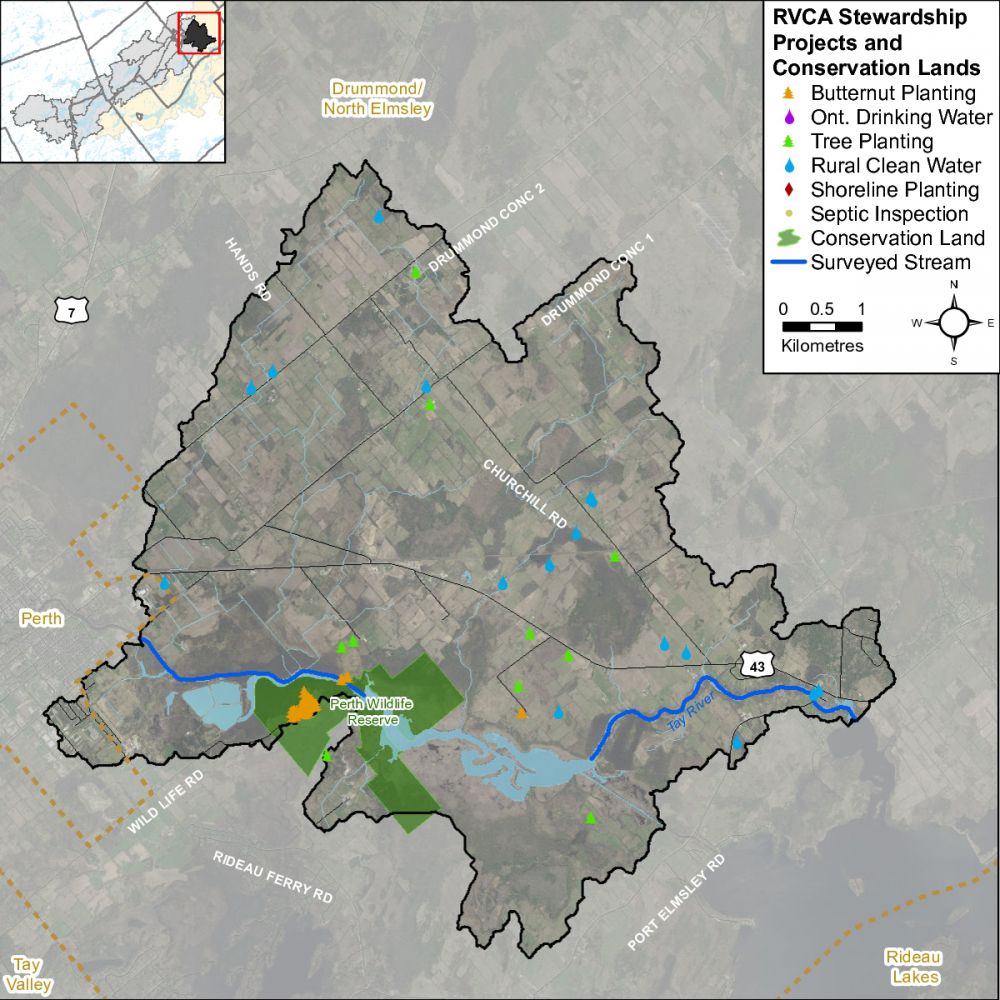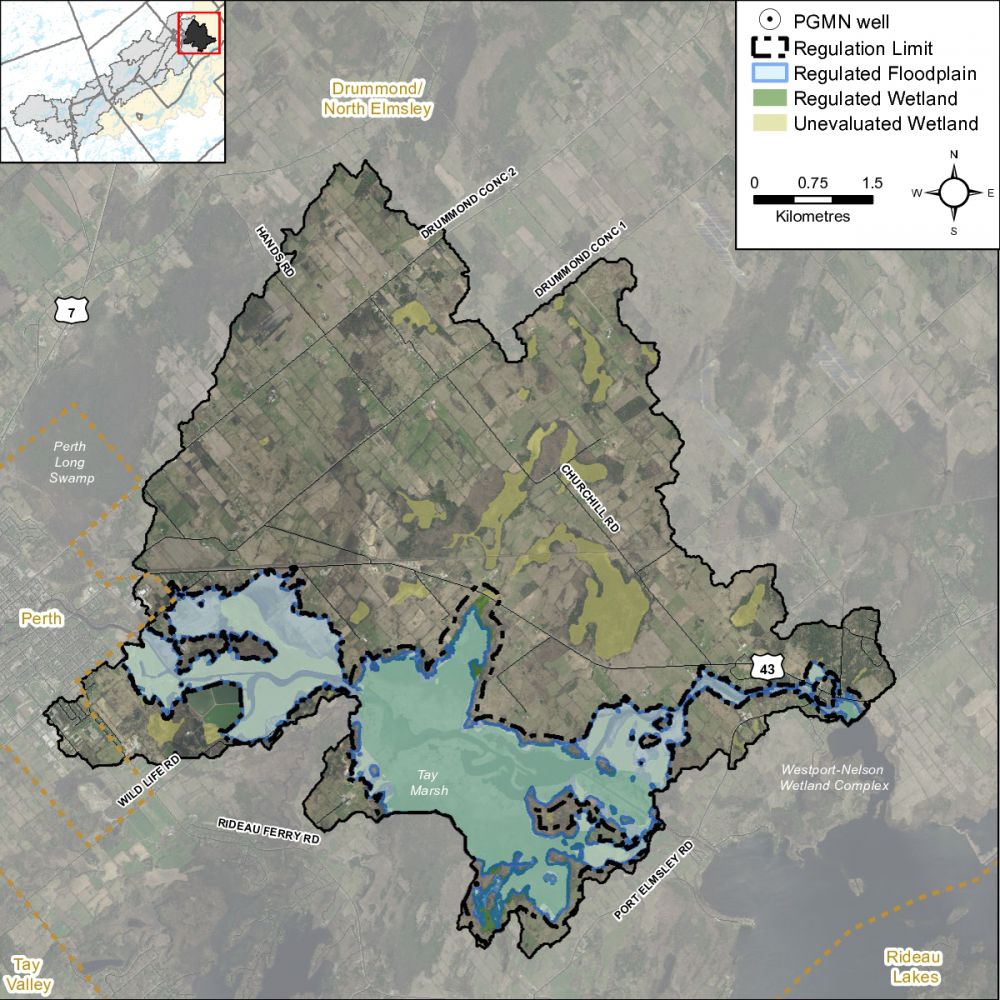5.0 Port Elmsley Catchment: Stewardship and Water Resources Protection
The RVCA and its partners are working to protect and enhance environmental conditions in the Tay River Watershed. Figure 52 shows the location of all stewardship projects completed in the Port Elmsley catchment.
5.1 Rural Clean Water
The Rural Clean Water Program provides technical and financial assistance to farmers and other rural landowners, to aid in the implementation of projects that protect water quality. Funding is granted to those projects that support best management practices for application in the protection and improvement of surface and ground water resources. The program also supports climate change adaptation and low impact development projects as well as educating rural landowners about environmental stewardship of private property. Examples of supported projects include livestock exclusion fencing, controlled tile drainage, cover crops, erosion control, well related projects, and many more. For a list of eligible projects and to apply for funding, see Rural Clean Water.
In the Port Elmsley catchment from 2011 to 2016, two well decommissionings, one septic system repair, one well upgrade, one education initiative and one livestock fencing project were completed; prior to this, four livestock fencing projects, three septic system repairs, three well upgrades, two well decommissionings and one well replacement had been completed.
When combined, these projects are keeping 60.49 kilograms of Phosphorus out of our lakes, rivers and streams every year. Total value of all 19 projects is $94,803 with $39,177 of that amount funded through grant dollars from the RVCA.
5.2 Private Land Forestry
Forest cover and tree planting continues to be one of the most widely supported strategies to improve our environment. The many benefits of forest cover include carbon sequestration, flood mitigation and water quality improvement as well as providing wildlife habitat.
Through the RVCA's Trees for Tomorrow Program (and its predecessors), 18,700 trees were planted at five sites from 2011 to 2016; prior to this, 25,830 trees were planted at five sites. In total, 44,530 trees have been planted resulting in the reforestation of 24 hectares. Total project value of all ten projects in the Port Elmsley catchment is $72,353 with $50,588 of that amount coming from fundraising sources. For more information about the Program and landowner eligibility, please see the following: Tree Planting in the Rideau Valley Watershed and Trees for Tomorrow.
An additional 152 butternut trees were planted through the RVCA Butternut Recovery Program in the Port Elmsley catchment, as part of efforts to introduce healthy seedlings from tolerant butternuts into various locations across Eastern Ontario.
5.3 Shoreline Naturalization
Natural shoreline buffers rich in native plants are critically important to protecting the health of our lakes, rivers and streams. Shoreline vegetation protects water quality and aquatic habitat by intercepting potentially harmful contaminants such as nutrients, pollutants and sediment, regulating water temperatures, slowing runoff and providing important fish and wildlife habitat. Natural shorelines also help improve climate change resiliency by increasing flood storage and providing protection from erosion during extreme weather events.
As of the end of 2016, no shoreline projects had been carried out in the Port Elmsley catchment. Landowners may wish to take advantage of the RVCA's Shoreline Naturalization Program to assist them with the naturalization of their shorelines to see the benefits noted above (and more).
5.4 Valley, Stream, Wetland and Hazard Lands
The Port Elmsley catchment covers 50.9 square kilometres with 12.8 square kilometres (or 25.1 percent) of the drainage area being within the regulation limit of Ontario Regulation 174/06 (Figure 53), giving protection to wetland areas and river or stream valleys that are affected by flooding and erosion hazards.
Wetlands occupy 10 square kilometres (or 19.6 percent) of the catchment. Of these wetlands, six square kilometres (or 60 percent) are designated as provincially significant and included within the RVCA regulation limit. This leaves the remaining four square kilometres (or 40 percent) of wetlands in the catchment outside the regulated area limit.
Of the 66.6 kilometres of stream in the catchment, regulation limit mapping has been plotted along 26 kilometers of streams (representing 39 percent of all streams in the catchment). Some of these regulated streams (7.8 km) flow through regulated wetlands; the remaining 18.2 kilometres of regulated streams are located outside of those wetlands. Plotting of the regulation limit on the remaining 40.6 kilometres (or 61 percent) of streams requires identification of flood and erosion hazards and valley systems.
Within those areas of the Port Elmsley catchment subject to the regulation (limit), efforts (have been made and) continue through RVCA planning and regulations input and review to manage the impact of development (and other land management practices) in areas where “natural hazards” are associated with rivers, streams, valley lands and wetlands. For areas beyond the regulation limit, protection of the catchment’s watercourses is provided through the “alteration to waterways” provision of the regulation.
5.5 Vulnerable Drinking Water Areas
The Mississippi-Rideau Source Water Protection Program has mapped the southwestern boundary of the Port Elmsley catchment as a Significant Groundwater Recharge Areas and all of the catchment as a Highly Vulnerable Aquifer. This means that the nature of the overburden (thin soils, fractured bedrock) does not provide a high level of protection for the underlying groundwater making the aquifer more vulnerable to contaminants released on the surface. There are no Well-Head Protection Areas in the catchment.
The Mississippi-Rideau Source Protection Plan includes policies that focus on the protection of groundwater region-wide due to the fact that most of the region, which encompasses the Mississippi and Rideau watersheds, is considered Highly Vulnerable Aquifer. For detailed maps and policies that have been developed to protect drinking water sources, visit the Mississippi-Rideau Source Protection Region website.

